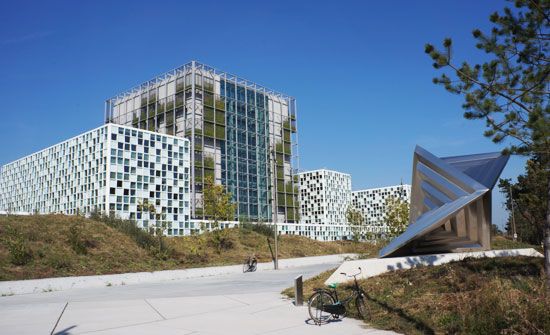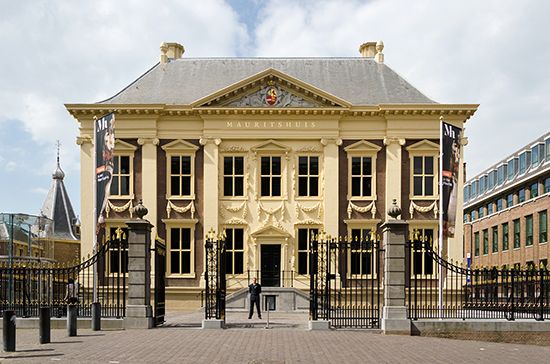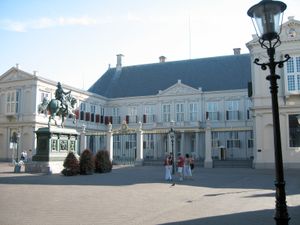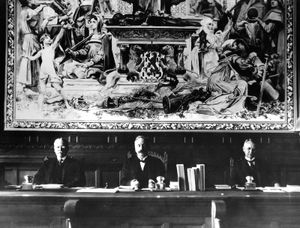The Hague
- Dutch:
- ’s-Gravenhage or Den Haag
- French:
- La Haye
What is The Hague known for?
Where is The Hague located?
How did The Hague get its name?
When did The Hague become the administrative capital of the Netherlands?
News •
The Hague, seat of government of the Netherlands. It is situated on a coastal plain, with the city centre just inland from the North Sea. The Hague is the administrative capital of the country and the home of the court and government, though Amsterdam is the official capital.
The city’s name recalls the hunting lodge of the counts of Holland, which was located in a woodland area called Haghe, or “hedge” (whence ’s-Gravenhage, “the counts’ private enclosure”). Count William II built a castle there in 1248, around which several buildings came to be clustered, and these became the principal residence of the counts of Holland. These buildings now form the Binnenhof (“Inner Courtyard”) in the old quarter of the city. Among the great halls around this courtyard are the Ridderzaal (Knight’s Hall; c. 1280) and the Armistice or Truce Hall, designed by Daniel Marot in 1697. An artificial lake, the Hofvijver, just to the north of the Binnenhof, was dug about 1350 and still forms one of the many attractions of the city.
A commercial district grew up around the Binnenhof in the 13th and 14th centuries, and it survives on shopping streets such as Venestraat, Spuistraat, Gravenstraat, and Hoogstraat. In the 16th century Holland became the chief centre of Dutch resistance to Spanish Habsburg rule, and in 1559 William I, stadtholder of the Netherlands, made The Hague his capital. About 1585 the States-General, along with other bodies of the Dutch Republic’s central government, established themselves in the Binnenhof. William’s son, Prince Maurice of Orange, soon took up residence in The Hague, and at his initiative in 1616 a web of canals was constructed around the city that continued to define its borders to the mid-19th century. Around this time, imposing aristocratic mansions were constructed on the eastern side of the Binnenhof. To the southeast grew the Spui (craftsmen’s district) and small inner harbours, and to the west the Prinsegracht (home to the wealthy middle class), which was connected to the horticultural area of the Westland by the Loosduinse canal.

In the 17th century, when the Dutch Republic played a leading role in Europe, The Hague became a centre of diplomatic negotiation. From 1795 to 1808 The Hague served as the capital of the French-controlled republic of Holland, and, with liberation from the French, the city alternated with Brussels as the meeting place of the States General of the enlarged Kingdom of the Netherlands from 1815 to 1830. After 1850, when the revenues from the Dutch East Indies started to pour in, the city prospered, and many of the older canals were filled in to allow for development. As a result of the international conferences (Hague Convention) held there in 1899 and 1907, The Hague became a permanent centre of international law. After a long sojourn in Amsterdam, the Dutch central government returned to The Hague in 1913.
The city expanded rapidly in the early 20th century, with growth being characterized by broad avenues, parks, and public gardens. In the north the Benoordenhout quarter was built, and the fine residential park district of Marlot was constructed near Wassenaar. In the southwest the Zuiderpark districts were laid out, containing many blocks of residential flats. Along the dunes in the west and near the Laan van Meerdervoort and Loosduinseweg small villas were built, and middle-class housing was constructed in the Bomen- en Bloemenbuurt and the Fruit Quarter. These new districts linked The Hague with the popular seaside resort of Scheveningen, Rijswijk, Voorburg, and other adjoining municipalities.
There is little heavy industry in The Hague, which is basically a centre of government and corporate administration. The States General (parliament) meets in the Knights’ Hall, and government departments and foreign embassies occupy other buildings in the old quarter of the city. Most of the city’s business firms are engaged in trade, banking, insurance, or other services. Several large oil companies also have their international headquarters in the city. The Hague is also a leading centre for international conferences. The city’s industries include printing and publishing, electronics, food processing, and the production of ceramics, furniture, glass, and various luxury consumer items.
The Binnenhof is surrounded by buildings dating from the 15th to the 18th century. Among these historical landmarks are the Great Church of St. Jacob (Jacobskerk; 1399), which has a hexagonal tower and a richly decorated late Gothic choir, as well as the largest carillon in the Netherlands; the Protestant New Church (1654); the royal palace on the Noordeinde (16th century); the royal palace known as the House in the Wood (Huis ten Bosch; 1645–47); and the old Renaissance-style town hall (1564), which was subsequently enlarged several times.
South of the Binnenhof is the Buitenhof, a centre of the town’s activities and the site of several hotels and restaurants. The original entrance to it was the Gevangenpoort (Prisoner’s Gate), a tower and gate built about 1400. It is now a museum dedicated to the history of punishment and torture in the Netherlands. Just north of the Binnenhof lies the Hofvijver (Court Pond), a rectangular artificial pond with a small island in the centre. Close by is the Old Catholic Church (1722), which has a beautiful Baroque interior. The Hague is home to two residences of the Dutch royal family. The Noordeinde Palace was first built in the 16th century. The other royal palace, Huis ten Bosch, dates from 1640 and was designed by Pieter Post and Jacob van Campen. It has a beautiful hall with a domed roof.
To the north the Permanent Court of Arbitration and the United Nations’ International Court of Justice are housed in the Peace Palace, an imposing building that was completed in 1913 with an endowment from the American industrialist Andrew Carnegie. Among the city’s more striking modern buildings are the headquarters of the Royal Dutch/Shell Group (1941), the KLM (Royal Dutch Airlines) building (1949), the United States Embassy (1959), Dr. Anton Philips Hall (1987), a concert venue, and the headquarters of the International Criminal Court (2015).
The numerous museums in the city comprise a wide range of collections. The Royal Picture Gallery, housed in the famous building known as the Mauritshuis (1633–44), has a remarkable collection of the works of the Dutch masters: Rembrandt, Johannes Vermeer, Jan Steen, and others. The Bredius Museum (1645) also has a fine collection of old paintings of the Dutch school. Other notable museums are the Mesdag Museum, the Mesdag Panorama, the Municipal Museum, and the Museum for Communication. The Royal Library, established in 1798, has the most important collection of old books and manuscripts in the country. There are several art academies, and musical life is dominated by The Hague Philharmonic orchestra. The city also has some notable parks and recreation areas. It has excellent road and rail connections with Rotterdam, Amsterdam, and Utrecht. Pop. (2017 est.) 524,882.



































